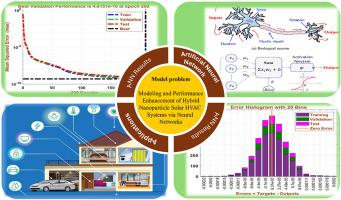Modeling and performance optimization of non-Newtonian hybrid nanofluid solar HVAC systems with magnetic effects using neural networks
IF 9.4
1区 工程技术
Q1 ENERGY & FUELS
引用次数: 0
Abstract
The current study develops a computational framework to examine the integration of Sutterby magneto-hybrid nanofluid (SMHNF) boundary layer behavior into solar-powered heating, ventilation, and air conditioning (HVAC) systems to enhance thermal performance and energy efficiency through artificial intelligence techniques. A hybrid nanofluid consisting of Cu (copper) and SiO2 (silicon dioxide) nanoparticles dissolved in propylene glycol (PG) is used to represent the system under the influence of different physical effects, including activation energy, chemical reactions, and solar thermal radiation. To improve physical realism, a three-dimensional model is built that includes Smoluchowski thermal slipping and velocity slip characteristics. The governing partial differential equations are modified utilizing transformation analysis, which is derived from conservation laws, into nonlinear ordinary differential equations. The implementation of a linked numerical-ANN technique allows for the prediction and validation of system behavior under a variety of scenarios. The BVP4C solver in MATLAB offers a reference dataset for training a backpropagation neural network using the Levenberg-Marquardt algorithm. Strong consistency between artificial neural network (ANN) estimations and numerical findings is demonstrated by function fitness analysis with errors of approximately 10−04, error histograms, mean squared error evaluation with range 10−10 to 10−08, gradient of values 10−09, and best regression analysis. The research results reveal that solar radiation and magnetic field strength considerably improve solar-HVAC systems' heat transfer performance. Physically, the results show that increases in slippery speed and rotation parameters reduce the velocity profile, whereas increases in thermal and radiative parameters raise the temperature field and enhance heat transfer. For the design and engineering aspects and optimization of comprehensive thermal management mechanisms in renewable energy applications, the suggested modeling and predicting methodology offers valuable insight.

基于神经网络的非牛顿混合纳米流体太阳能暖通空调系统建模与性能优化
目前的研究开发了一个计算框架来研究将萨特比磁混合纳米流体(SMHNF)边界层行为集成到太阳能供暖、通风和空调(HVAC)系统中,以通过人工智能技术提高热性能和能源效率。用一种由Cu(铜)和SiO2(二氧化硅)纳米颗粒溶解在丙二醇(PG)中的混合纳米流体来表示不同物理效应(包括活化能、化学反应和太阳热辐射)影响下的体系。为了提高物理真实感,建立了包含Smoluchowski热滑移和速度滑移特征的三维模型。利用由守恒定律导出的变换分析将控制偏微分方程修正为非线性常微分方程。链接数字-人工神经网络技术的实现允许在各种场景下预测和验证系统行为。MATLAB中的BVP4C求解器为使用Levenberg-Marquardt算法训练反向传播神经网络提供了参考数据集。通过函数适应度分析(误差约为10−04)、误差直方图、均方误差评估(范围为10−10 ~ 10−08)、梯度值(10−09)和最佳回归分析,证明了人工神经网络(ANN)估计与数值结果之间的强一致性。研究结果表明,太阳辐射和磁场强度显著改善了太阳能-暖通空调系统的传热性能。物理上,滑移速度和旋转参数的增加降低了速度分布,而热和辐射参数的增加提高了温度场并增强了传热。对于可再生能源应用中综合热管理机制的设计和工程方面以及优化,建议的建模和预测方法提供了有价值的见解。
本文章由计算机程序翻译,如有差异,请以英文原文为准。
求助全文
约1分钟内获得全文
求助全文
来源期刊

Energy
工程技术-能源与燃料
CiteScore
15.30
自引率
14.40%
发文量
0
审稿时长
14.2 weeks
期刊介绍:
Energy is a multidisciplinary, international journal that publishes research and analysis in the field of energy engineering. Our aim is to become a leading peer-reviewed platform and a trusted source of information for energy-related topics.
The journal covers a range of areas including mechanical engineering, thermal sciences, and energy analysis. We are particularly interested in research on energy modelling, prediction, integrated energy systems, planning, and management.
Additionally, we welcome papers on energy conservation, efficiency, biomass and bioenergy, renewable energy, electricity supply and demand, energy storage, buildings, and economic and policy issues. These topics should align with our broader multidisciplinary focus.
 求助内容:
求助内容: 应助结果提醒方式:
应助结果提醒方式:


